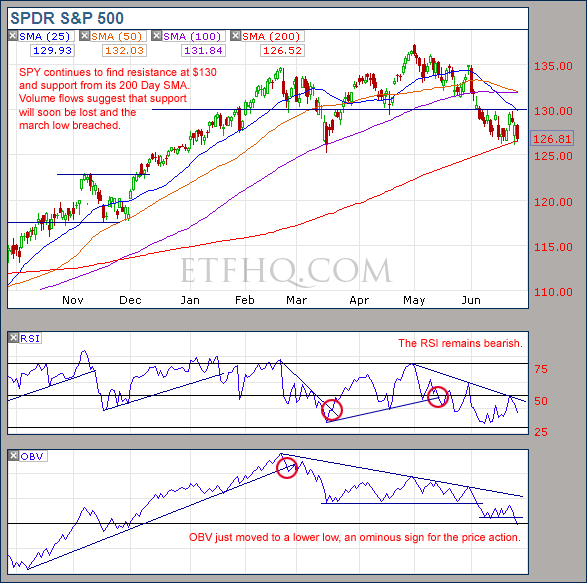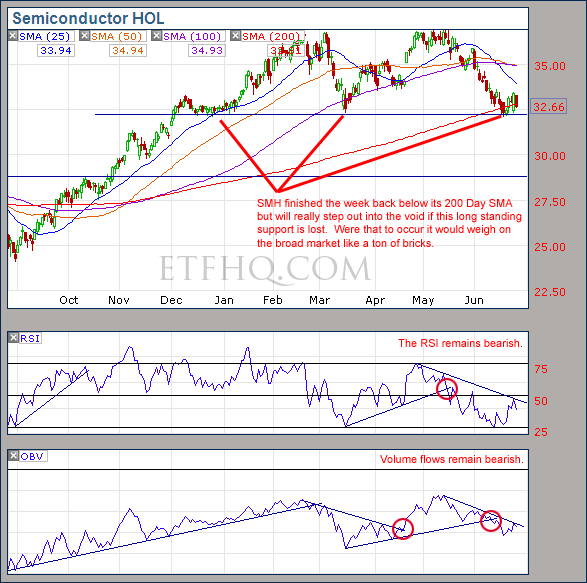June 27, 2011 – 08:05 am EDT
There was a churning around support levels over the last week. Impressive action was seen from the small caps which is some good news in a world where everything looks bearish. Lets take a closer look…
** Wow, big growth in our number of subscribers over the last week. We don’t advertise so THANK YOU for spreading the word!
.
ETF % Change Comparison
.

It was interesting to see such strong performance by the small caps (IWM) while SPY and DIA continued to decline. This suggests that although the market is unlikely to turn into a raging bull any time soon, it is also not as sick as many think. If it were, then money would not be seeking out an area as economically sensitive as the small caps.
Learn more – ETF % Change Comparison
.
![]()
.
A Look at the Charts
.

Volume on SPY suggests support will soon fail.
.

QQQ finishing another week lingering below support; not a good sign.
.

The last ditch support on SMH will be key to the markets next move.
.

IWM is offering one of the few bullish arguments.
.

Volume out of ITY is a concern.
.
![]()
.
OM3 Weekly Indicator
.

Sell signals across the board but there is one bull alert from IWM.
Learn more – The OM3 Indicator
.
![]()
.
TransDow & NasDow
.

TransDow – The Transports remain dominant over the Dow and the Trade in DJT is currently showing a profit of 1.08% after one week.
NasDow – The Dow remains dominant over the NASDAQ and the NasDow remains in cash.
.
What the TransDow Readings tell us:
The TransDow measures dominance between the DJ Transportation Index (DJTI) and the Dow Jones Industrial Average (DJIA). In a strong market the more economically sensitive Transportation Index should be dominant over the DJIA.
Historically the DJTI has been dominant over the Dow 45% of the time. The annualized rate of return from the DJTI during this period was 18.47% with the biggest loss for one trade sitting at -13.27%. The annualized return from the DJIA during the periods it was dominant over the DJTI was just 4.06% and the biggest loss for one trade was -16.13%. A 4% stop-loss is applied to all trades adjusting positions only at the end of the week.
What the NasDow Readings tell us:
The NasDow measures dominance between the NASDAQ and the DJIA. Using the same theory behind the Trans Dow; in a strong market the more economically sensitive NASDAQ should be dominant over the DJIA.
Historically the NASDAQ has been dominant over the DJIA 44% of the time. Taking only the trades when the NASDAQ is above its 40 week moving average the annualized rate of return was 25.47% with the biggest loss for one trade sitting at –8.59%. The annualized rate on the DJIA during the periods it was dominant over the NASDAQ is just 8.88% and the biggest loss for one trade was –12.28%. A 8% stop-loss is applied to all trades adjusting positions only at the end of the week.
.
![]()
.
LTMF 80 & Liquid Q
.

Both LTMF 80 and Liquid Q remain in cash.
.
Historical Stats:
.

.
How The LTMF 80 Works
LTMF stands for Long Term Market Forecaster. It reads volume flows relative to price action and looks for out performance of volume measured on a percentage basis over the prior 12 months. During a sustained rally the readings will reach high levels (near 100%) making it imposable for the volume reading to always outperform price so any reading above 80% will maintain the buy signal. This system has outperformed the market over the last 10 years but performance has been damaged by some nasty losses. It only produces buy signals and only for QQQ.
How Liquid Q Works
Liquid Q completely ignores price action and instead measures the relative flow of money between a selection of economically sensitive and comparatively stable ares of the market. It looks for times when the smart money is confident and and can be seen by through volume investing heavily is more risky areas due to an expectation of expansion. This system has outperformed the market over the last 10 years and remained in cash through most of the major declines. It only produces buy signals and only for QQQ. We will provide more performance details on the web site for these systems soon.
.
![]()
.
Summary
Volume out of SPY and IYT is deteriorating which suggests that even if the bulls can stage a rally it will be short lived. It is also bearish to see SMH and QQQ finish another week below their 200 Day SMAs. A new low from SMH now would be fatal and likely pull the broad market down significantly. But in the mean time we are sitting on a pocket of relative safety where the Small Caps are offering reason to look on the bright side of life.
Any disputes, questions, queries, comments or theories are most welcome in the comments section below.
.
Cheers
Derry
And the Team @ ETF HQ
“Equipping you to win on Wall St so that you can reach your financial goals.”
.
![]()
.
Quote of the Day
“Absorb what is useful, discard what is useless, and add what is uniquely your own.” – Bruce Lee
.
.
Derry,
Remember that QE-2 ends in several days….. What happens after the end of June will be instructive…… My bet (and position) is that we are going to witness a repeat of the selling that occurred at the end of QE-1……… I’ve already found it instructive that the selling began with just the announcement…… Perhaps the fundamentals are really much worse this time than last, aye? I’ve been inverted since the announcement of the end around May 2nd and that has been very profitable….
Mike
That is a nice short Mike. Our largest position of currently short INP (India). These are fascinating times and I can’t wait to see how it all plays out.